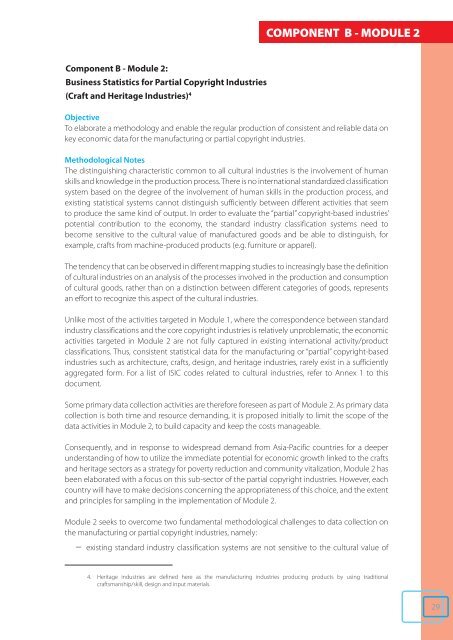Statistics on Cultural Industries - International Trade Centre
Statistics on Cultural Industries - International Trade Centre
Statistics on Cultural Industries - International Trade Centre
- No tags were found...
You also want an ePaper? Increase the reach of your titles
YUMPU automatically turns print PDFs into web optimized ePapers that Google loves.
COMPONENT B - MODULE 2Comp<strong>on</strong>ent B - Module 2:Business <str<strong>on</strong>g>Statistics</str<strong>on</strong>g> for Partial Copyright <strong>Industries</strong>(Craft and Heritage <strong>Industries</strong>) ObjectiveTo elaborate a methodology and enable the regular producti<strong>on</strong> of c<strong>on</strong>sistent and reliable data <strong>on</strong>key ec<strong>on</strong>omic data for the manufacturing or partial copyright industries.Methodological NotesThe distinguishing characteristic comm<strong>on</strong> to all cultural industries is the involvement of humanskills and knowledge in the producti<strong>on</strong> process. There is no internati<strong>on</strong>al standardized classificati<strong>on</strong>system based <strong>on</strong> the degree of the involvement of human skills in the producti<strong>on</strong> process, andexisting statistical systems cannot distinguish sufficiently between different activities that seemto produce the same kind of output. In order to evaluate the “partial” copyright-based industries’potential c<strong>on</strong>tributi<strong>on</strong> to the ec<strong>on</strong>omy, the standard industry classificati<strong>on</strong> systems need tobecome sensitive to the cultural value of manufactured goods and be able to distinguish, forexample, crafts from machine-produced products (e.g. furniture or apparel).The tendency that can be observed in different mapping studies to increasingly base the definiti<strong>on</strong>of cultural industries <strong>on</strong> an analysis of the processes involved in the producti<strong>on</strong> and c<strong>on</strong>sumpti<strong>on</strong>of cultural goods, rather than <strong>on</strong> a distincti<strong>on</strong> between different categories of goods, representsan effort to recognize this aspect of the cultural industries.Unlike most of the activities targeted in Module 1, where the corresp<strong>on</strong>dence between standardindustry classificati<strong>on</strong>s and the core copyright industries is relatively unproblematic, the ec<strong>on</strong>omicactivities targeted in Module 2 are not fully captured in existing internati<strong>on</strong>al activity/productclassificati<strong>on</strong>s. Thus, c<strong>on</strong>sistent statistical data for the manufacturing or “partial” copyright-basedindustries such as architecture, crafts, design, and heritage industries, rarely exist in a sufficientlyaggregated form. For a list of ISIC codes related to cultural industries, refer to Annex 1 to thisdocument.Some primary data collecti<strong>on</strong> activities are therefore foreseen as part of Module 2. As primary datacollecti<strong>on</strong> is both time and resource demanding, it is proposed initially to limit the scope of thedata activities in Module 2, to build capacity and keep the costs manageable.C<strong>on</strong>sequently, and in resp<strong>on</strong>se to widespread demand from Asia-Pacific countries for a deeperunderstanding of how to utilize the immediate potential for ec<strong>on</strong>omic growth linked to the craftsand heritage sectors as a strategy for poverty reducti<strong>on</strong> and community vitalizati<strong>on</strong>, Module 2 hasbeen elaborated with a focus <strong>on</strong> this sub-sector of the partial copyright industries. However, eachcountry will have to make decisi<strong>on</strong>s c<strong>on</strong>cerning the appropriateness of this choice, and the extentand principles for sampling in the implementati<strong>on</strong> of Module 2.Module 2 seeks to overcome two fundamental methodological challenges to data collecti<strong>on</strong> <strong>on</strong>the manufacturing or partial copyright industries, namely:–existing standard industry classificati<strong>on</strong> systems are not sensitive to the cultural value of. Heritage industries are defined here as the manufacturing industries producing products by using traditi<strong>on</strong>alcraftsmanship/skill, design and input materials.29
















